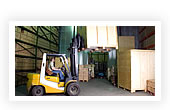 |
F.A.Q. |
| |

|
| How should I measure a box? |
Always take measurements from the INTERIOR of your boxes.
Enter your dimensions in the following order:
Length x Width x Height
Dimensions are in inches. If your measures are in cm, simply DIVIDE your numbers by 2.51 to obtain the equivalent in inches. |
| How is box strength determined? |
When looking through our cardboard shipping box order forms and featured inventory list, you will see numbers under the column "Test". What does this mean? The Burst Test (aka Mullen Test) measures the force, expressed in pounds per square inch, required to rupture or burst the side of a cardboard box. This indicates the ability of the box to withstand external or internal forces and how the box will contain its contents during rough handling. A box with burst strength of 125 lbs per sq. inch indicates that the cardboard used to make the box can withstand 125 lbs of pressure per square inch.
Edge Crush Test (ECT) measures the stacking strength of corrugated cardboard boxes. Compression strength is defined by the amount of force, in pounds per square inch that is needed to crush cardboard by standing it on its edge. For example, a box with an ECT rating of 32 lbs per square inch indicates that the cardboard used in the box, standing on edge, can withstand a force of 32 lbs per square inch before crushing.
|
| Single-wall Corrugated Board, used in standard boxes |
Burst Strength
(Mullen) |
Maximum Weight
(Box Content) |
Edge Crush Test
(ECT) |
| 125 psi |
20 lbs |
23 |
| 150 psi |
35 lbs |
26 |
| 175 psi |
50 lbs |
29 |
| 200 psi |
65 lbs |
32 |
| 250 psi |
80 lbs |
40 |
| 275 psi |
95 lbs |
44 |
| 350 psi |
120 lbs |
55 |
|
| Double-wall Corrugated Board, used in heavy duty boxes |
Burst Strength
(Mullen) |
Maximum Weight
(Box Content) |
Edge Crush Test
(ECT) |
| 200 psi |
80 lbs |
42 |
| 275 psi |
100 lbs |
48 |
| 350 psi |
120 lbs |
51 |
| 140 psi |
140 lbs |
61 |
| 160 psi |
160 lbs |
71 |
| 180 psi |
180 lbs |
82 |
|
| What is the difference between a "used" box and a "new" box and a "stock" box on your inventory list? |
| These boxes are carefully inspected, one at a time, in order to ensure their quality and cleanliness. Essentially, these boxes have the same qualities as new boxes, at a fraction of the price. The new boxes are overruns or misprints - boxes ordered by manufacturers that are extras that they don't need for shipping goods, or the box manufacturer/printer made a mistake in the printing on the box. As these boxes were all originally custom orders, they come in a wide variety of sizes and styles and our inventory changes constantly. Stock boxes are standard-sized, unprinted, new boxes that we always carry. |
| What is a "die-cut" box? |
| Die-cut boxes are one-piece panels scored and folded together. Unlike regular slotted cartons, they do not have a manufacturer's joint, where two side panels come together fastened with tape, glue or staples. Typical examples include book-fold or book-wrap boxes, often used for mailing books, shoe boxes with tuck-in flaps and many mailer-style boxes. |
| What kinds of payment do you accept? |
We accept cash, credit cards (MasterCard and Visa), and company cheques.
Please contact us for terms of payments at 905.276.7929. |
|
|
|
| Contact Us Today |
 |
|
|
|

